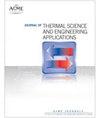Simulation of Heat and Mass Transfer in a Moving Bed Part-fluidized Boiler
IF 1.4
4区 工程技术
Q3 ENGINEERING, MECHANICAL
引用次数: 0
Abstract
Moving bed part-fluidized boiler is a new type of furnace. The new combustion method in the furnace has attracted a lot of attention and shown attractive prospects. Two-dimensional computational fluid dynamic (CFD) simulations were performed for a 116 MW moving bed part-fluidized boiler to investigate the different combustion patterns of coal particles of different particle sizes inside the furnace chamber. A low-NOX combustion method based on the combination of laminar combustion and fluidized combustion is proposed. By comparing the effects of different air distributions on the fluidization state of coal particles, the air distribution values required for optimal fluidized combustion were obtained. The temperature field and pollutant distribution in the furnace chamber for the conventional combustion method and the new combustion method were also simulated. The results show that the combustion technology combining laminar combustion and fluidization of a moving bed part-fluidized boiler can significantly improve the combustion rate and reduce the NOX concentration at the furnace exit. When the secondary air speed is up to 15m/s, the coal particles smaller than 5mm are fully fluidized and burned in the whole furnace chamber. The coal particles larger than 5mm are burned on the bed. The pollutant emission of the boiler can reach the best condition. The new type of boiler can reach a super clean emission in which the NOX emission value is below 47mg/m3, and the SO2 emission value is reduced to 0.15mg/m3.移动床部分流化锅炉中的传热和传质模拟
移动床部分流化锅炉是一种新型炉型。这种新型炉内燃烧方式引起了广泛关注,并展现出诱人的前景。对 116 MW 移动床部分流化锅炉进行了二维计算流体动力学(CFD)模拟,以研究不同粒径的煤颗粒在炉膛内的不同燃烧模式。提出了一种基于层流燃烧和流化燃烧相结合的低氮燃烧方法。通过比较不同空气分布对煤颗粒流化状态的影响,得出了最佳流化燃烧所需的空气分布值。此外,还模拟了传统燃烧方法和新燃烧方法的炉膛温度场和污染物分布。结果表明,移动床部分流化锅炉的层流燃烧与流化相结合的燃烧技术可显著提高燃烧率,降低炉膛出口的氮氧化物浓度。当二次风速达到 15m/s 时,小于 5mm 的煤粒在整个炉膛内充分流化燃烧。大于 5mm 的煤粒在炉床上燃烧。锅炉的污染物排放达到最佳状态。新型锅炉可实现超洁净排放,氮氧化物排放值低于 47mg/m3 ,二氧化硫排放值降至 0.15mg/m3 。
本文章由计算机程序翻译,如有差异,请以英文原文为准。
求助全文
约1分钟内获得全文
求助全文
来源期刊

Journal of Thermal Science and Engineering Applications
THERMODYNAMICSENGINEERING, MECHANICAL -ENGINEERING, MECHANICAL
CiteScore
3.60
自引率
9.50%
发文量
120
期刊介绍:
Applications in: Aerospace systems; Gas turbines; Biotechnology; Defense systems; Electronic and photonic equipment; Energy systems; Manufacturing; Refrigeration and air conditioning; Homeland security systems; Micro- and nanoscale devices; Petrochemical processing; Medical systems; Energy efficiency; Sustainability; Solar systems; Combustion systems
 求助内容:
求助内容: 应助结果提醒方式:
应助结果提醒方式:


